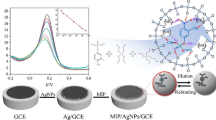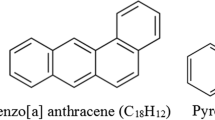Abstract
This work demonstrated the possibility to integrate electrochemical molecularly imprinted polymers (e-MIPs) on microelectrodes to detect organic pollutants. e-MIPs are a cross-linked polymer with specific target binding cavities with a redox tracer inside. e-MIPs were obtained by precipitation copolymerization of ferrocenylmethyl methacrylate as a functional monomer and a redox tracer with ethylene glycol dimethacrylate as a cross-linker and bisphenol A as a target molecule. FTIR and elemental analysis confirmed the presence of ferrocene inside the polymers. Nitrogen adsorption/desorption experiments and binding isotherms demonstrated the presence of binding cavities inside the e-MIP. The electrochemical properties of the e-MIP were characterized in organic/aqueous media before their patterned on microelectrode.




Similar content being viewed by others
References
K. Haupt and K. Mosbach: Molecularly imprinted polymers and their use in biomimetic sensors. Chem. Rev. 100, 2495–2504 (2000).
L. Ye and K. Haupt: Molecularly imprinted polymers as antibody and receptor mimics for assays, sensors and drug discovery. Anal. Bioanal. Chem. 378, 1887–1897 (2004).
L. Uzun and A.P.F. Turner: Molecularly-imprinted polymer sensors: realising their potential. Biosens. Bioelectron. 76, 131–144 (2016).
M.C. Blanco-López, M.J. Lobo-Castañón, A.J. Miranda-Ordieres, and P. Tuñón-Blanco: Electrochemical sensors based on molecularly imprinted polymers. TrAC Trends Anal. Chem. 23, 36–48 (2004).
S.A. Piletsky and A.P.F. Turner: Electrochemical sensors based on molecularly imprinted polymers. Electroanalysis 14, 317–323 (2002).
F. Canfarotta, R. Rapini, and S. Piletsky: Recent advances in electrochemical sensors based on chiral and nano-sized imprinted polymers. Curr. Opin. Electrochem. 7, 146–152 (2018).
C. Malitesta, E. Mazzotta, R.A. Picca, A. Poma, I. Chianella, and S.A. Piletsky: MIP sensors–the electrochemical approach. Anal. Bioanal. Chem. 402, 1827–1846 (2012).
P.S. Sharma, A. Pietrzyk-Le, F. D’Souza, and W. Kutner: Electrochemically synthesized polymers in molecular imprinting for chemical sensing. Anal. Bioanal. Chem. 402, 3177–3204 (2012).
P.S. Sharma, A. Wojnarowicz, M. Sosnowska, T. Benincori, K. Noworyta, F. D’Souza, and W. Kutner: Potentiometric chemosensor for neopterin, a cancer biomarker, using an electrochemically synthesized molecularly imprinted polymer as the recognition unit. Biosens. Bioelectron 77, 565–572 (2016).
C. Branger, H. Brisset, and D. Udomsap: University of Toulon. French Patent. FR 1000175817. 21/12/2012. PCT/IB2013/ 061196 - 20/12/2013, 2012. US Patent 20,150,344,607, 2015.
D. Udomsap, C. Branger, G. Culioli, P. Dollet, and H. Brisset: A versatile electrochemical sensing receptor based on a molecularly imprinted polymer. Chem. Commun. 50, 7488–7491 (2014).
D. Udomsap, H. Brisset, G. Culioli, P. Dollet, K. Laatikainen, H. Siren, and C. Branger: Electrochemical molecularly imprinted polymers as material for pollutant detection. Mater. Today Commun. 17, 458–465 (2018).
V. Mba Ekomo, C. Branger, R. Bikanga, A.-M. Florea, G. Istamboulie, C. Calas-Blanchard, T. Noguer, A. Sarbu, and H. Brisset: Detection of bisphenol A in aqueous medium by screen printed carbon electrodes incorporating electrochemical molecularly imprinted polymers. Biosens. Bioelectron. 112, 56–161 (2018).
V. Mba Ekomo, C. Branger, R. Bikanga, G. Istamboulie, C. Calas-Blanchard, T. Noguer, and H. Brisset: Screen printed carbon electrodes incorporating electrochemical molecularly imprinted polymers to detect pollutant. In 17th International Meeting on Chemical Sensors, 2018; pp. 219–220. doi:10.5162/IMCS2018/EC2.2.
E. Mazzotta, A. Turco, I. Chianella, A. Guerreiro, S.A. Piletsky, and C. Malitesta: Solid-phase synthesis of electroactive nanoparticles of molecularly imprinted polymers. A novel platform for indirect electrochemical sensing applications. Sens. Actuat. B Chem. 229, 174–180 (2016).
S. Rebocho, C.M. Cordas, R. Viveiros, and T. Casimiro: Development of a ferrocenyl-based MIP in supercritical carbon dioxide: towards an electrochemical sensor for bisphenol A. J. Supercrit. Fluids 135, 98–104 (2018).
J. Corrales, L.A. Kristofco, W.B. Steele, B.S. Yates, C.S. Breed, E.S. Williams, and B.W. Brooks: Global assessment of bisphenol A in the environment: review and analysis of its occurrence and bioaccumulation. Dose-Response 13, 1–29 (2015).
V.K. Sharma, G.A.K. Anquandah, R.A. Yngard, H. Kim, J. Fekete, K. Bouzek, A.K. Ray, and D. Golovko: Nonylphenol, octylphenol, and bisphenol-A in the aquatic environment: a review on occurrence, fate, and treatment. J. Environ. Sci. Health A 44, 423–442 (2009).
C. Zhang, Y. Li, C. Wang, L. Niu, and W. Cai: Occurrence of endocrine disrupting compounds in aqueous environment and their bacterial degradation: a review. Crit. Rev. Environ. Sci. Technol. 46, 1–59 (2016).
M.S. Muhamad, M.R. Salim, W.J. Lau, Z. Yusop, and T. Hadibarata: The removal of bisphenol A in water treatment plant using ultrafiltration membrane system. Water Air. Soil Pollut. 227, 250 (2016).
Z. Fan, J. Hu, W. An, and M. Yang: Detection and occurrence of chlorinated byproducts of bisphenol A, nonylphenol, and estrogens in drinking water of China: comparison to the parent compounds. Environ. Sci. Technol. 47, 10841–10850 (2013).
L. Padhye, H. Yao, F.T. Kung’u, and C.-H. Huang: Year-long evaluation on the occurrence and fate of pharmaceuticals, personal care products, and endocrine disrupting chemicals in an urban drinking water treatment plant. Water Res. 51, 266–276 (2013).
S. Koide and K. Yokoyama: Electrochemical characterization of an enzyme electrode based on a ferrocene-containing redox polymer. J. Electroanal. Chem. 468, 193–201 (1999).
J. Wang, P.A.G. Cormack, D.C. Sherrington, and E. Khoshdel: Monodisperse molecularly imprinted polymer microspheres prepared by precipitation polymerization for affinity separation applications. Angew. Chem. Int. Ed. 42, 5336–5338 (2003).
G. Socrates: Infrared and Raman Characteristic Group Frequencies–Tables and Charts. 3rd ed. (J. Wiley & Sons, New York, 2001).
O. Okay: Macroporous copolymer networks. Prog. Polym. Sci. 25, 711–779 (2000).
W. Meouche, K. Laatikainen, A. Margaillan, T. Silvonen, H. Siren, T. Sainio, I. Beurroies, R. Denoyel, and C. Branger: Effect of porogen solvent on the properties of nickel ion imprinted polymer materials prepared by inverse suspension polymerization. Eur. Polym. J. 87, 124–135 (2017).
Acknowledgments
The authors acknowledge financial supports from ANBG (Agence Nationale des Bourses du Gabon) and SATT Sud-Est. The authors acknowledge Dr. Paschalis Gkoupidenis for helpful discussions.
Author information
Authors and Affiliations
Corresponding author
Supplementary material
Supplementary material
The supplementary material for this article can be found at https://doi.org/10.1557/mrc.2020.29.
Rights and permissions
About this article
Cite this article
Ekomo, V.M., Branger, C., Gavrila, AM. et al. Electrochemical molecularly imprinted polymers in microelectrode devices. MRS Communications 10, 324–331 (2020). https://doi.org/10.1557/mrc.2020.29
Received:
Accepted:
Published:
Issue Date:
DOI: https://doi.org/10.1557/mrc.2020.29




